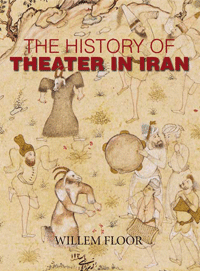
God wears boots
Analysis
March 29, 2006
iranian.com
"The Power Structure of the Islamic Republic of Iran: transition from populism to clientelism, and militarization of the government" published in Third World Quarterly (December 2005). Full text PDF
ABSTRACT
Since the1979 revolution, Iran has experienced two non-class power structures -- populism and clientelism. Populism, a product of the revolution, helped Ayatollah Khomeini to rule Iran for a decade with absolute power. Clientelism in Iran is linked to Shiism, as well as to a rentier state, and to the revolution, which resulted in many autonomous groups formed in patron – client bonds. Neither clientelism nor Shiism can be analysed using classical class system theory. Instead of horizontal layers of classes, the power structures in both Shi’ism and clientelism are based on vertical columns of rival and autonomous groups. The traditional Shi’a institution of Marja’iyat (source of emulation), has come into conflict with an elected government. The reformist government elected in 1997 failed to deliver on its democratic promises and to end the destructive role of autonomous groups. Therefore, disenchanted with state-sponsored reforms, Iranian society seems to be moving towards pragmatism and utilitarianism, while the political power structure leans towards militarism.
Seventy years of conflict and challenge between monarchism, religious traditionalism, regionalism, tribalism, nationalism and the political left finally ended in the revolution of 1979 and the establishment of the Islamic Republic of Iran (IRI). This period had begun with the Constitutional Revolution of 1905. Reza shah ended regionalism and tribalism and established a nation-state for the first time in Iranian history. Constitutional monarchism, however, culminated in the dictatorship of Mohammad Reza shah Pahlavi following a military coup in 1953. During Mohammad Reza shah’s rule, foreign investments and higher oil revenues helped Iran to pave the way to capitalist development and a class system. Twenty-five years after the coup, however, a major revolution ended the shah’s power and monarchy. As a consequence, the political structure changed from an autocratic class system to a religious populist regime, a tyranny of the majority under the charismatic leadership of Ayatollah Ruhollah Khomeini.
Populism is a non-class structure with a charismatic leadership. It is a political, ideological and centralised radical mass movement. Ideologically it represents the declining traditional middle class. A populist movement occurs when a society enters a structural crisis of transition from an agrarian system to capitalism. Contemporary Iranian history is marked with these characteristics. The land reform programme of 1961 and the shah’s modernisation project aimed to replace the agrarian economy with capitalist relations and the neutralising of any revolutionary motives on the part of the peasants.
However, it resulted in a ‘peasantisation’ of the cities, cultural and economic conflict, unregulated social mobility, and stratification, which set the stage for Khomeini’s revolutionary populism. In a religious culture like that of Iran, and in the absence of political parties, when the shah lost his firm grip on his regime a charismatic leader who proclaimed himself God’s representative on earth and the people’s saviour easily manipulated the uneducated masses, who had no political experience. Khomeini’s populist slogans were altogether directed against one figure, the shah. However, after the victory of the revolution, relying on his new populist base, Khomeini viciously excluded all his rivals and political opponents.
Populist Islamic rule, which is incompatible with the trend of modernisation and democratisation, pushed society into a permanent revolution, involving traditional authority, Islamisation of the social fabric and fragmentation of political desires. Had the war with Iraq (1981 – 88) not occurred, populism could have ended more quickly after the revolution, and society would have begun its routine activities. The war, however, empowered the populist Islamist authority to mobilise the ideologically illtreated masses and to suppress political opponents under the emotional context of defending ‘the land of Islam’.
The religious base of clientelism in Iran
Populism finally ended with the termination of the war in 1988 and the death of Ayatollah Khomeini in 1989. No one could replace the unique persona of Khomeini, who was a religious, political and spiritual leader of millions of people who followed his beliefs in search of an ideal society.1 The Council of Experts’ selection of the new supreme leader, Ayatollah Ali Khamenei, was caused by a rift within the ruling clerical groups. Khamenei is not a marja’a taqlid, the most revered of the grand ayatollahs, as required by the Iranian constitution.2 Evidently his selection was merely a political decision by the ruling group to overcome possible factional dispute. However, the vacuum of a populist leader after the death of Khomeini resulted in a dispersal of millions of supporters who had become disillusioned, in turn, with Islamic slogans. The death of Khomeini ended the absolute and unified hierarchy of power and opened the gate to the traditional multiple objects of emulation (maraja’a taqlid), which is the norm in Shiism. In a first move the dominant group purged rival powerful ayatollahs such as Mowsavi Ardabili (former head of the judicial branch) and Azari Qomi (a leading member of the Council of Experts and founder of the conservative daily newspaper Resaallat). However, they could not stop the conservative, right-wing and radical zealots, who organized their own client – patron bonds under the name of velayat-e faqih (jurisprudence).
 The principal religious base of the IRI, according to its constitution, is 12-imam Shiism. ‘All Shiite lay persons must choose a learned and upright cleric, whose rulings on the details of religious practice theymust follow.’3 In its religious interpretation, adherents are free to choose their own marja’a taqlid (object of emulation). Marja’a (pl Maraja’a¼ulama) are independent sources and can have their own fiqh, or code of behaviour, for their adherents. Traditionally, ulama are expected to arrive at their decisions completely independently of one another, that is, no ulama should follow (taqlid) other ulama. Some schools of Islamic law forbid taqlid outright. In Iran in the 19th century there developed the notion of the marja’a-at taqlid: this individual was so learned and so perfect that it was incumbent on the ulama to follow (taqlid) his decisions.4 The principal religious base of the IRI, according to its constitution, is 12-imam Shiism. ‘All Shiite lay persons must choose a learned and upright cleric, whose rulings on the details of religious practice theymust follow.’3 In its religious interpretation, adherents are free to choose their own marja’a taqlid (object of emulation). Marja’a (pl Maraja’a¼ulama) are independent sources and can have their own fiqh, or code of behaviour, for their adherents. Traditionally, ulama are expected to arrive at their decisions completely independently of one another, that is, no ulama should follow (taqlid) other ulama. Some schools of Islamic law forbid taqlid outright. In Iran in the 19th century there developed the notion of the marja’a-at taqlid: this individual was so learned and so perfect that it was incumbent on the ulama to follow (taqlid) his decisions.4
There is a deliberate split in decision making and power between the secular professionals on the one hand and the ideological and religious figures on the other hand. After the 1979 revolution marja’a taqlid became a political fixture in Iran, and political rivals now use the religious umbrella to justify their economic and political interests. Thousands of appointed city and town congregational imams set the macro and micro policies of the state, which often surpass or override the decisions of the elected government. Even Majlis (ie parliament) deputies have to restrict their decisions in accordance with the religious codes. Laws passed in parliament need final approval of the Council of Guardians, a body of six appointed clerics and six appointed lawyers, to ensure that they do not contradict shari‘a (the Islamic codes) or the constitution. Some Majlis deputies, before instigating a bill, travel to the holy city of Qom to receive the approval of Maraja’a. In religious terms this has moved the power structure into a new stage of clientelism, in which the elected legislative body takes a subordinate position to an influential clergy and its associates.
The current political power structure in Iran is based on a Shi’a hierarchy, a system characterised by multiple objects of emulation and parallel power, which operates concurrently with clientelism. The power structure in Shiism is primarily based on a voluntary relationship between a faqih (jurisprudence) and his adherents. In clientelism the power structure is based on a voluntary relationship between a patron and his clients. In addition to religion, two other major factors -- the rentier state and self-established and financially self-sufficient religious organisations -- have pushed the political structure into clientelism. Given the current situation, it seems apparent that Iran cannot achieve democracy and the complete rule of law unless clientelism is replaced by a class system. What is clientelism?
Clientelism is a structured relationship between a patron and a client. The term ‘patron’ is derived from the Spanish patron, meaning a superior, or a person of power, status, authority, and influence.5 A ‘client’ is a subordinate actor who serves his or her patron in exchange for reciprocal rewards.6 In Iran some patrons may themselves be clients to more powerful patrons in the national hierarchy of patronage. Clientelism is a non-class system with a power structure that consists of separate vertical rival groups rather than horizontal class layers. Such a structure crosses classes, occupations and ethnic identities, and it organises society based on family or mafia-style relationships -- ie cliques and clans based on patron – client interests. Definitions of clientelism vary, but all have three common characteristics that link patron and client:
 1) inequality of power, status and wealth; 2) reciprocity in the exchange of goods and services; and 3) the proximity of personal and face-to-face relationships, which create a sense of trust between two parties.7 Christopher Clapham defines clientalism as ‘a relationship of exchange between unequals’.8 For example, it may be a trade of protection and services between patron and client. These characteristics show that clientelistic groups share bonds that cut across social classes and levels of society. Edward B Reeves, re-emphasising Eisenstadt and Lemarchand, pinpoints seven general characteristics of clientelism that help us to understand the current Iranian political power structure. They are as follows. 1) inequality of power, status and wealth; 2) reciprocity in the exchange of goods and services; and 3) the proximity of personal and face-to-face relationships, which create a sense of trust between two parties.7 Christopher Clapham defines clientalism as ‘a relationship of exchange between unequals’.8 For example, it may be a trade of protection and services between patron and client. These characteristics show that clientelistic groups share bonds that cut across social classes and levels of society. Edward B Reeves, re-emphasising Eisenstadt and Lemarchand, pinpoints seven general characteristics of clientelism that help us to understand the current Iranian political power structure. They are as follows.
1. The relationship between patron and client is personal.
2. The relations are characterised by an exchange of different types of resources. Generally the patron provides material and political resources, and these are reciprocated in the form of diffuse loyalty and labour services provided by the client.
3. The relationship between patron and client is based on unconditional mutual trust.
4. The relation between patron and client is a voluntary and informal contract; law or the power of the state does not sanction it.
5. ‘Patron – client relations evolve into networks of persons rather than being relations between organized corporate groups, and they seem to undermine the solidarity of patron and client alike.’
6. The relations are predicated on material and political inequality, because patron and client occupy different positions.
7. Mutual trust and the obligation of kinship solidarity between patron and client are highly important because each actor is in danger of being thwarted by the other actor’s short-run calculations of personal security and advantage.9
Iranian clientelism is combination of the patrimonial and the saintly, in which both traditional and religious relations between superior and subordinates have been revived. Reeves, who has studied Muslim communities in Egypt, writes: ‘I suggest that the role of the saint is guided by universal standards rather than particularistic criteria. This means that the saintly patronage . . . measures up to normative criteria which derive their authority from the Prophet and God.’10 In justification of the patron (saint) and client (devotee) relationship, he adds: ‘The saint has a personal relationship with God, because of his close relationship with the Prophet, which ordinary mortals do not have’.11 The current political and legal system in Iran is heavily influenced by this view, with the multiple centres of power being based on different interpretations of this religious authority as representative of God on earth. The self-determined statuses in an Islamic system allow those in authority to have unique access to the various sources of income and power, and they exchange portions of this income and power for client services.
 Clientelism as a non-class system Clientelism as a non-class system
Like populism, clientelism prevents the formation of class structure. In populism followers are emotionally manipulated by the leader’s unique qualities, and the existence of the system is dependent upon the leader. In clientelism, by contrast, the clients are aware of their subordinate positions because they have interests in the patron – client relations and the maintenance of the system.12 This characteristic makes the system difficult to break. Clientelism disintegrates class, occupational and ethnic solidarity, and instead organises people into rival groups and clique- or clan-types of relations. The vertical poly-class structure of clientelism, again, is based on patron–client interests, and this becomes the source of the political power structure of society, which operates beyond the government’s control and the rule of law and creates decreased security and increased risk. As Eric Wolf (1997) says, clientelism dominates when general laws are weak. Clients who receive the full support of their patrons also undermine laws.
Clientelistic relations that prevent class division and consequently economic development feed corruption. Not only patrons and clients but also ordinary people tend to achieve their demands by accepting the necessity of bribing government agencies rather than exerting pressure for legal and political reforms. In their study of Italy Frank Belloni and Mario Caciaghi conclude that clientelism produces crisis in society and prevents the emergence of class because clientelism eliminates many citizens who could be positively active in the political and civil arenas in the development of society.13 Peter Flynn also confirms that the lack of class division is an obstacle to development.14 In addition, studies of southern Italy by Banfield and Bertran Hutchinson emphasise the role of clientelism as a brake on economic development in the region.15 >>> Full text with citations (PDF)
About
Kazem Alamdari is in the Department of Sociology, California State University, 5151 State University Drive, Los Angeles, CA 90032-8228, USA.
|